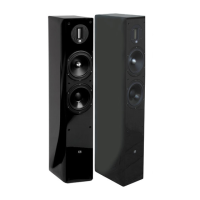
Do you have a question about the XTZ 99.36 MKII Piano and is the answer not in the manual?
| Impedance | 4 ohms |
|---|---|
| Recommended Amplifier Power | 50-300W |
| Type | 3-way, bass reflex |
| Woofer | 6.5" coated paper cone |
| Frequency Response | 30 kHz |
| Crossover Frequencies | 2.5 kHz |
| Dimensions | 200 x 300 mm |
XTZ's philosophy focuses on creating natural sound, acknowledging that acoustics are subjective.
XTZ aims to provide the best value for money by optimizing production and reducing marketing costs.
XTZ contact details including website and email address.
Describes the cabinet's acoustically advantageous narrow baffle design, sturdy MDF construction, and internal bracing for stability.
Details the ribbon tweeter's superior transient and flat frequency response, construction, magnet system, and high-frequency capability.
Describes the 6.5" Seas Excel magnesium driver, its lightweight and stiff cone, high-flow basket, and features reducing distortion.
Details the SEAS coated paper bass driver, its lightweight and stiff cone, high-flow basket, and features reducing distortion.
Explains the -12/18 dB crossover, gold-plated bi-wiring terminals, and the four coupling modes for signal distribution.
Provides instructions for safely unpacking the speaker, saving the box, and contacting the retailer in case of damage.
Lists the accessories included with the speaker, such as bass reflex plugs, user manual, and level adjustment loops.
Discusses the importance of the listening environment and provides basic rules for proper loudspeaker installation.
Explains how room furnishings like carpets and curtains affect sound, and how hard surfaces cause detrimental reflections.
Details how placement near walls or corners can amplify bass frequencies, potentially causing indistinct sound, and suggests placement guidelines.
Warns that furniture can vibrate and produce noise at high volume levels.
Advises avoiding square rooms or rooms where length is twice the width due to potential unwanted resonances.
Explains how subwoofer placement significantly impacts room frequency response and sound level, affecting phase differences with main speakers.
Recommends using short, clean, and stable connections for all cables, separating signal cables from power and loudspeaker cables.
Advises symmetrical placement of front speakers, with a distance of 80% of listener distance, resulting in a 45° angle.
Outlines advantages of using two subwoofers, including higher SPL, improved room frequency response, and reduced power requirements.
Emphasizes that good sound is subjective and encourages experimentation to achieve personal preference.
Discusses standard wall placement and how rear/side walls affect bass level and characteristics, advising experimentation with distance.
Instructs to connect amplifier and speaker terminals with correct polarity (+ to +, - to -) to ensure proper sound reproduction.
Warns about the risk of overloading drivers and amplifiers at high loads and suggests caution with volume and EQ adjustments.
Advises that drivers require 50-100 hours of initial playing time to reach optimal sound performance.
Explains how bass plugs adjust the lower boundary frequency and bass response (Deep, Quick, Neutral), influenced by room and taste.
Provides a recommended neutral setting for average rooms (20m²), specifying bass plug configuration and initial treble/bass levels.
Details the four modes for adjusting treble level using loop connectors, from neutral to increased or decreased levels.
Explains the four modes for adjusting bass level using loop connectors, offering neutral to increased levels.
Describes the binding post configurations and biwiring options, including default settings and modes for feeding individual drivers.
Details the 2 1/2-way construction, separate bass reflex chambers, adjustable bass modes (Room Tuning), and adjustable treble/bass levels.
Specifies the loudspeaker's physical dimensions in millimeters (Width x Height x Depth).
Indicates the weight of the loudspeaker per piece.
States whether the loudspeaker is magnetically shielded.
Specifies the nominal impedance range of the loudspeaker.
Describes the type of binding posts used, including gold plating and compatibility with bi-wiring, banana plugs, and pole screws.
Provides the loudspeaker's sensitivity rating in decibels.
Specifies the short-term and long-term power handling capabilities according to IEC 268-5 standard.
Lists key specifications for the tweeter driver, including its type, materials, and compatibility.
Details the 6.5" SEAS Excel magnesium driver, its features, and weight.
Provides specifications for the 6.5" SEAS coated paper bass driver, including its construction and magnet.
Summarizes connection options (bi-wiring) and adjustable settings like bass reflex modes and treble/bass level adjustments.
Explains the DIY service approach, allowing users to send defective parts for exchange, with advice on seeking help.
Clarifies warranty coverage for DIY repairs, stating it applies if the original defect was manufacturing-related, but not for self-inflicted damage.
Directs users to their retailer for service and provides email and web page for further inquiries.
Offers free support for installation advice or troubleshooting, via email with phone number for callbacks.